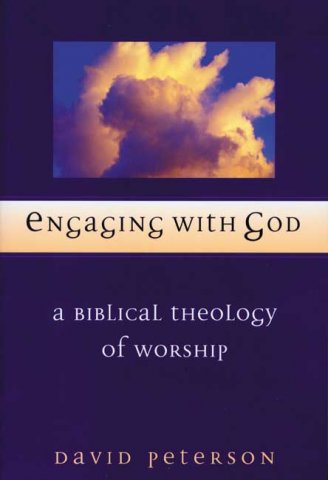Book Review: Engaging with God, by David Peterson
May 3, 2014

May 3, 2014
David Peterson, Engaging with God: A Biblical Theology of Worship. InterVarsity Press, 2002. 318 pages. $26.00.
David Peterson’s Engaging with God is one of those books that ends too soon. Not only that, but you want to reread nearly every sentence because you’re afraid you’ve missed something.
So I just want to be clear from the starting block: anyone involved with the worship ministry of a church should read this book. Those interested in good biblical theology should read this book. Pretty much everyone reading this review should read this book. Let me show you why.
Peterson proposes to test the following hypothesis against the data of Scripture: “[The] worship of the living and true God is essentially an engagement with him on the terms that he proposes and in the way that he alone makes possible” (20, emphasis his).
He begins his test by surveying the Old Testament to determine its overall view of worship. The key to understanding its view, he says, is that “the God of heaven and earth has taken the initiative in making himself known.” And this action on God’s part is progressive. It was given “first to the patriarchs of Israel and then, through the events of the exodus from Egypt and the encounter on Mount Sinai, to the nation as a whole” (48). The symbols of the ark, the tabernacle, and then the temple entailed a whole system of worship that acknowledged God’s initiative to make himself known.
Peterson then examines Old Testament vocabulary for worship, describing the human side of engaging with God. This enlightening chapter covers terminology that demonstrates Old Testament worship as grateful submission, service, and reverence. Each of these terms connects these attitudes with actions associated with the tabernacle and temple. These attitudes are not limited to those particular actions, but instead spread out into “faithfulness and obedience to all the covenant demands of God.” In other words, worship is a matter of one’s “total lifestyle” (73).
Peterson’s next terrain to cover is the Gospels. Focusing on Matthew and John in particular, he demonstrates how these two Gospels “develop a picture of Jesus as the fulfillment of everything that the temple stood for and the focus of worship under the new covenant” (81). “Develop” is the right word since Jesus’ life and ministry demonstrate a massive shift: his coming marks the end of the temple’s role in the life of a true worshiper. In other words, “Jesus fulfills the hopes of the Old Testament writers and replaces all the provisions for engaging with God that were laid upon Israel” (102). He lives his life as a faithful Jew even as he ushers in this great change.
Because Christ replaces the temple and because “his ministry opens up a new way to engage with God,” what he accomplishes is “the messianic salvation.” His work makes available “the blessings of the new covenant” (109). It is this last point that primarily demonstrates the transformation of worship that has taken place from the Old Testament to the New Testament. The law, with its sacrificial system, is fulfilled in Jesus, and so the whole Old Testament pattern of worship is transformed in Jesus. Therefore, engagement with God in worship must occur through Jesus.
Sweeping through the book of Acts, Peterson notes that “Christ fulfills and replaces the temple and the whole method of approach to God associated with it” (137). Thus the first Christians engaged with God in quite a new way. It’s true that they kept meeting in the temple to pray at first, but eventually there were significant changes. Individually they could only engage with God through personal repentance and faith in Christ. But then on the corporate level they “met to express their relationship together to the Lord and their responsibilities in that relationship” (159, emphasis added). As worship, these expressions were quite different from those found in the Old Testament.
For the Apostle Paul, this centering of worship on Jesus means that “expressions of faith in the saving work of Jesus Christ and ministries that encourage such faith are specifically the worship acceptable and pleasing to God in the gospel era” (187). Thus, when the church meets, “the concept of edification” gains “central importance” (196). This edification comes through the Holy Spirit’s application of Scripture, building up the new temple: the church in union with Christ.
The book of Hebrews shows that the people of God “may now draw near without the aid of human priesthood, but only because they rely on the priestly mediation of Jesus Christ” (239). And the book of Revelation—with its call to faithfulness to Christ amidst persecution—defines worship as “faith in God’s promises worked out in the obedience of everyday life” (269, emphasis his). This faith springs from “confidence in the finished work of Jesus and his promises about the future” (279).
In a summary chapter, Peterson brings things together by saying that “worship is . . . fundamentally faith expressing itself in obedience and adoration” (283).
One might quibble with Peterson’s exegetical conclusions here and there. For example, not all readers will agree with Peterson’s view of prophecy in the New Testament. He basically follows Wayne Grudem’s view that New Testament prophets cannot be equated with Old Testament prophets (196ff).
But you get the sense as you read that Peterson has very carefully read the Bible at multiple levels. He consistently lays out the plain meaning of texts even as he digs deeper, showing that, as Jesus said, “everything written about me in the Law of Moses and the Prophets and the Psalms must be fulfilled” (Luke 24:44). Peterson takes the theme of worship and follows its biblical-theological path through the canon of Scripture. The result of that journey is this excellent, important book.